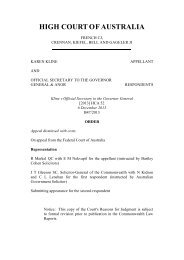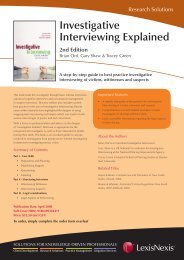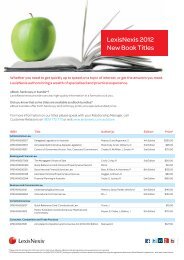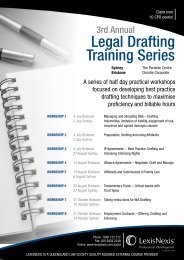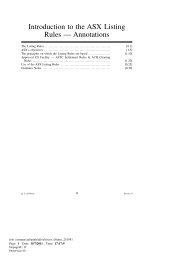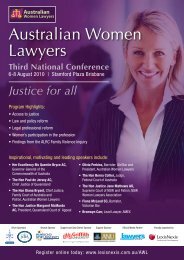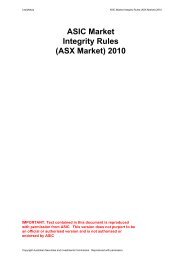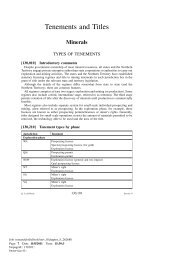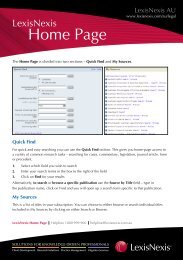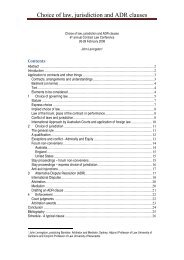Copyright LexisNexis. Sample only, not for classroom use or ...
Copyright LexisNexis. Sample only, not for classroom use or ...
Copyright LexisNexis. Sample only, not for classroom use or ...
You also want an ePaper? Increase the reach of your titles
YUMPU automatically turns print PDFs into web optimized ePapers that Google loves.
CHAPTER 12: EQUITABLE ESTOPPEL<br />
to the land. However, no proprietary estoppel claim is available if the plaintiff and defendant have a<br />
legally en<strong>f<strong>or</strong></strong>ceable contract relating to the property: Giumelli v Giumelli (1999) 196 CLR 101 at 121;<br />
161 ALR 473 at 482; Riches v Hogben [1985] 2 Qd R 292 at 301. As Young CJ in Eq observed in Barnes<br />
v Alderton [2008] NSWSC 107 at [55], ‘contract and proprietary estoppel are mutually exclusive’.<br />
12.18 Due to the two methods by which the assumption of an interest could arise, proprietary<br />
estoppel was recognised as comprising two streams. The first is estoppel by encouragement, which<br />
was described by Handley JA in Dela<strong>f<strong>or</strong></strong>ce v Simpson-Cook (2010) 78 NSWLR 483 at 488, as follows:<br />
Such an estoppel comes into existence when an owner of property has encouraged a<strong>not</strong>her to alter<br />
his <strong>or</strong> her position in the expectation of obtaining a proprietary interest and that other, in reliance<br />
on the expectation created <strong>or</strong> encouraged by the property owner, has changed his <strong>or</strong> her position<br />
to their detriment. If these matters are established equity may compel the owner to give effect to<br />
that expectation in whole <strong>or</strong> in part.<br />
12.19 Dillwyn v Llewelyn [1862] All ER 384 is the classic example of estoppel by encouragement.<br />
In that case a father put his son into possession of land which he purp<strong>or</strong>ted to voluntarily convey<br />
to his son. The conveyance was ineffective. With his father’s assent and approval, the son built and<br />
occupied a ho<strong>use</strong> on the land. After the father’s death, the son sought a declaration that he was the<br />
owner of the land in equity and that the trustees of the land be <strong>or</strong>dered to convey the land to him<br />
absolutely. The Ho<strong>use</strong> of L<strong>or</strong>ds made these <strong>or</strong>ders.<br />
12.20 The other stream of proprietary estoppel is estoppel by acquiescence, which was succinctly<br />
explained by Cranw<strong>or</strong>th LJ in Ramsden v Dyson (1866) LR 1 HL 129 at 140–1, as follows:<br />
If a stranger begins to build on my land supposing it to be his own, and I, perceiving his mistake,<br />
abstain from setting him right, and leave him to persevere in his err<strong>or</strong>, a Court of equity will<br />
<strong>not</strong> allow me afterwards to assert my title to the land on which he had expended money on the<br />
supposition that the land was his own. It considers that, when I saw the mistake into which he<br />
had fallen, it was my duty to be active and to state my adverse title; and that it would be dishonest<br />
in me to remain wilfully passive on such an occasion, in <strong>or</strong>der afterwards to profit by the mistake<br />
which I might have prevented.<br />
But it will be observed that to raise such an equity two things are required, first, that the person<br />
expending the money supposes himself to be building on his own land; and, secondly, that the<br />
real owner at the time of the expenditure knows that the land belongs to him and <strong>not</strong> to the<br />
person expending the money in the belief that he is the owner. F<strong>or</strong> if a stranger builds on my land<br />
knowing it to be mine, there is no principle of equity which would prevent my claiming the land<br />
with the benefit of all the expenditure made on it. There would be <strong>not</strong>hing in my conduct, active<br />
<strong>or</strong> passive, making it inequitable in me to assert my legal rights.<br />
12.21 F<strong>or</strong> a proprietary estoppel claim to be successful, the plaintiff must have suffered some<br />
detriment. In Barnes v Alderton at [42], Young CJ in Eq put it as follows:<br />
No equity arises to raise a proprietary estoppel unless the person in whose favour it is being raised,<br />
has acted to their prejudice <strong>or</strong> detriment in some way whether in terms of direct expenditure<br />
<strong>or</strong> on some other basis. However, the detriment may <strong>not</strong> necessarily be expenditure of money,<br />
comm<strong>only</strong> a claimant leaves her job, moves in with the promis<strong>or</strong> and does his ho<strong>use</strong>keeping <strong>f<strong>or</strong></strong><br />
many years … However, … min<strong>or</strong> expenditure such as day to day living expenses <strong>or</strong> min<strong>or</strong> repairs<br />
will <strong>not</strong> qualify.<br />
271<br />
<strong>Copyright</strong> <strong>LexisNexis</strong>. <strong>Sample</strong> <strong>only</strong>, <strong>not</strong> <strong>f<strong>or</strong></strong> <strong>classroom</strong> <strong>use</strong> <strong>or</strong> distribution.<br />
Spi-Radan & Stewart - Principles of Australian Equity and Trusts 2nd ed. Ch.12.indd 271 10/10/2012 05:22:31<br />
200595



